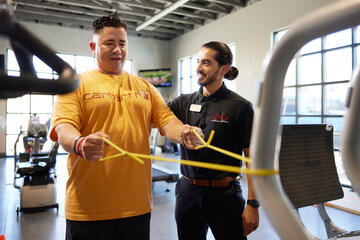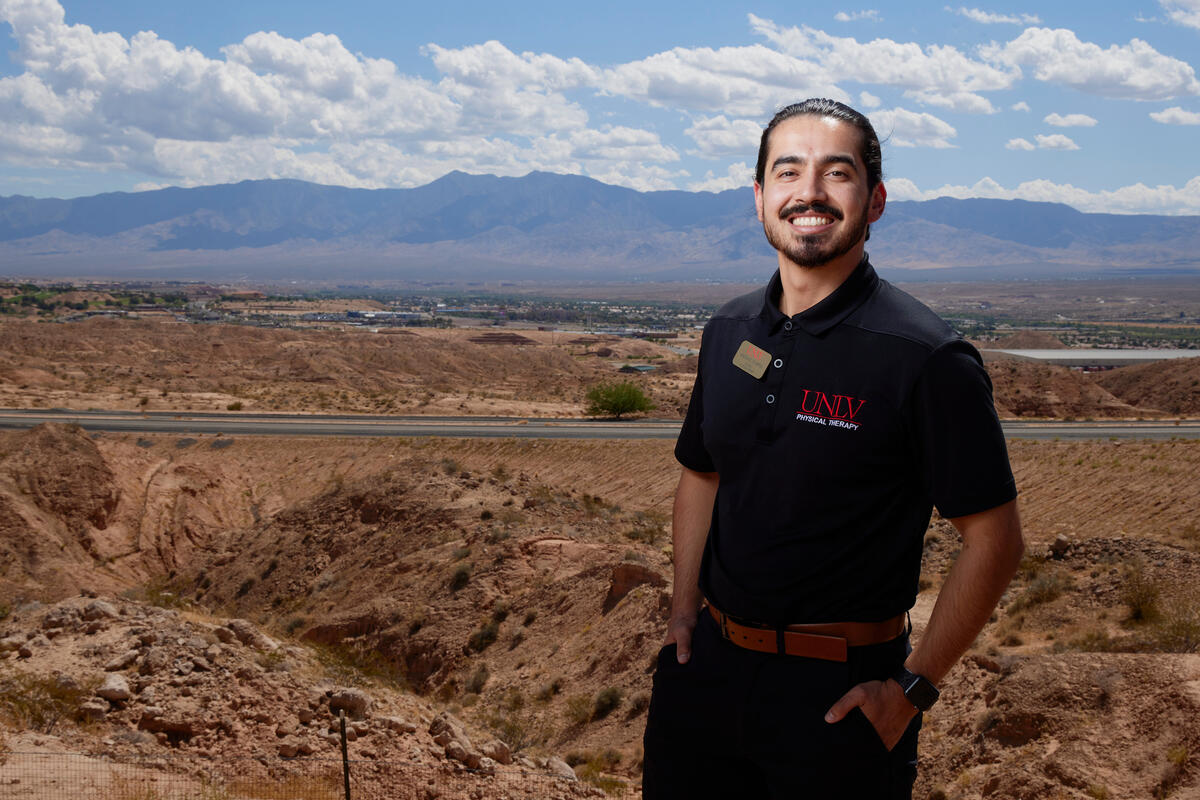One minute, you’re treating an elderly patient recovering from joint-replacement surgery, the next you’re working with patients who injured themselves on their farms or at work inside the mines.
As a small-town physical therapist, one must possess a knowledge of the rural milieu and remember that no two patient encounters are ever the same.
For UNLV’s physical therapy students working on their rural rotations, this is not only paramount to optimal patient care, it is critical to their instruction.

“The ability to think clinically and individualize a plan of care for a specific function has expanded my understanding of the need for physical therapy in rural areas,” said Michael Carpio, a second-year physical therapy student completing his clinical rotation at Mesa View Rehabilitation Center in Mesquite (pop. 21,000).
Carpio is one of 17 physical therapy students from the class of 2025 to complete his summertime rotation in a rural location.
According to Lisa Taylor, director of clinical education inside the School of Integrated Health Sciences, the physical therapy program's work in Nevada communities, including our rural communities, is embedded in its mission. Students are required to complete one of their four clinicals in an underserved or rural area. These clinical experiences are often reported by students as being extremely valuable to their growth as future clinicians.
They are also some of the most highly sought-after clinical experiences within the PT program.
“Students hear from the upper classes about their experiences in rural areas and this often sparks interest in them seeking out rural clinical experiences. In rural areas, our students get these opportunities to work with a large breadth of patient populations and get outside of their comfort zones. It makes them better clinicians,” Taylor said. “They can take the skills they learned in rural areas and use them wherever they go in their physical therapy careers.”
Physical therapy students have recently completed rural rotations in several locations across the state of Nevada, including Ely, Fallon, Gardnerville, Winnemucca, Minden, Pahrump, and Mesquite.
“Sometimes, our students who were raised in the city come with preconceived expectations about what it might be like to work in a rural area,” Taylor said. “Often, students who have clinical experiences in rural areas will report that they have experienced a strong sense of community while working in these communities. They also enjoyed the exposure to a wide variety of patient ages and diagnoses and felt like they not only learned so much but were able to really help patients in these often-underserved rural areas.”
For student Alekzander Hall, working at Full Range Physical Therapy in Elko (pop. 20,000) was the best clinical experience he’s had thus far.
“Not only did I get more experience as a physical therapy student, I also got to see just how different a rural setting is to a very populated city like Las Vegas,” he said.
According to Taylor, a rural clinic is defined as having a population of fewer than 50,000 residents and being at least 50 miles from the nearest Level 2 hospital.
Todd Brewster, a physical therapist and clinician at William Bee Ririe Hospital in Ely (pop. 4,000), has been working with UNLV’s physical therapy students for years. He credits them for bringing their energy, enthusiasm, and knowledge to keep his and his fellow therapists’ skills up-to-date.
He hopes that more students choose to work in rural settings after they graduate in order to fill a desperate need for small-town populations in Nevada and across the country.
“There is a critical need for rural health professionals because of the shrinking populations in many rural places combined with the retirement of many health care providers,” Brewster said. “When rural areas have sufficient providers, it dramatically improves the quality of life of rural populations. Patients have access to a wider variety and higher quality of medical provider, which allows them to be treated in their own community.”
With the closest large-scale hospitals and trauma centers located more than 200 miles from Ely, patients are forced to pay additional costs in gas and lodging in addition to their health care bills if they are forced to travel for care. Brewster said their desolate location has been referred by some as "frontier medicine."
Hall, who has called Las Vegas home since he was 4 years old, developed a deep affection for working in Elko. Located in the northeast corner of Nevada, approximately four hours in between Reno to the west and Salt Lake City to the east, Elko provided Hall with the opportunity to work with patients across the gamut.
“Some days I would start in pediatrics, then I’d work on an adult with a spinal cord injury and then with an athlete in rehab,” he said. “I would say the most important thing that I learned from this clinical is the absolute need that these rural communities have for medical staff of all different types.”
For Carpio, working in Mesquite also showed him the necessity for more Spanish-speaking health care providers in small-town settings.
“My clinical instructor informed me that half of his patient caseload are only Spanish speakers. As a native speaker, this was a great opportunity for me to contribute and communicate with our patients,” he said. “Improving my medical terminology and building rapport with patients was a great outcome working with the Mesa View team.”
Carpio said that working with a patient population that encompasses a wide range of ages and injuries will elevate his qualifications as a future physical therapist. Working with these patients, he added, required knowledge from all aspects of his UNLV curriculum.
For Taylor, that is precisely the point of these rotations.
“It makes me proud to be a part of the UNLV PT team because I consistently hear from our clinicians that our students are well prepared and are trying to learn as much as possible,” she said. “I am grateful that we have incredible clinical partnerships in many different areas and settings. These rural clinical partners are a big part of our students’ growth and learning and I am thankful to work with them.”



